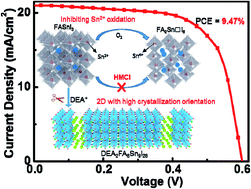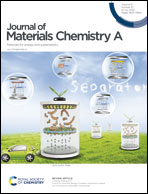Synergistic effect of two hydrochlorides resulting in significantly enhanced performance of tin-based perovskite solar cells with 3D to quasi-2D structural transition†
Abstract
The development of tin (Sn)-based perovskite solar cells has attracted extensive attention due to their strong infrared absorption and non-toxicity properties. However, the self-doping effect of Sn2+ oxidation leads to the generation of abundant vacancies of Sn, and the excessively fast crystallization rate also produces serious pinholes in the film. This hinders the further development of Sn-based perovskite devices. In this study, hydrazine monohydrochloride (HMCl) and diethylamine hydrochloride (DEACl) were simultaneously introduced into the precursor solution to suppress the oxidation of Sn2+ and decelerate the crystallization rate of the film, and thus, a high-quality quasi-2D DEA2FAn−1SnnI3n+1 film was obtained (FA: formamidinium). Additionally, DEA+ is confirmed as more beneficial for carrier transfer than BA+ and PEA+via density functional theory calculations and experimental evidence in the quasi-2D perovskite films. Consequently, under the synergistic effect of two hydrochlorides, a champion power conversion efficiency of 9.5% with ultra-high stability was realized due to a significant increase in VOC. This study demonstrated a new strategy to evidently enhance the performance and stability of Sn-based perovskite devices by causing the 3D to 2D structure transition via two functional additives.



 Please wait while we load your content...
Please wait while we load your content...